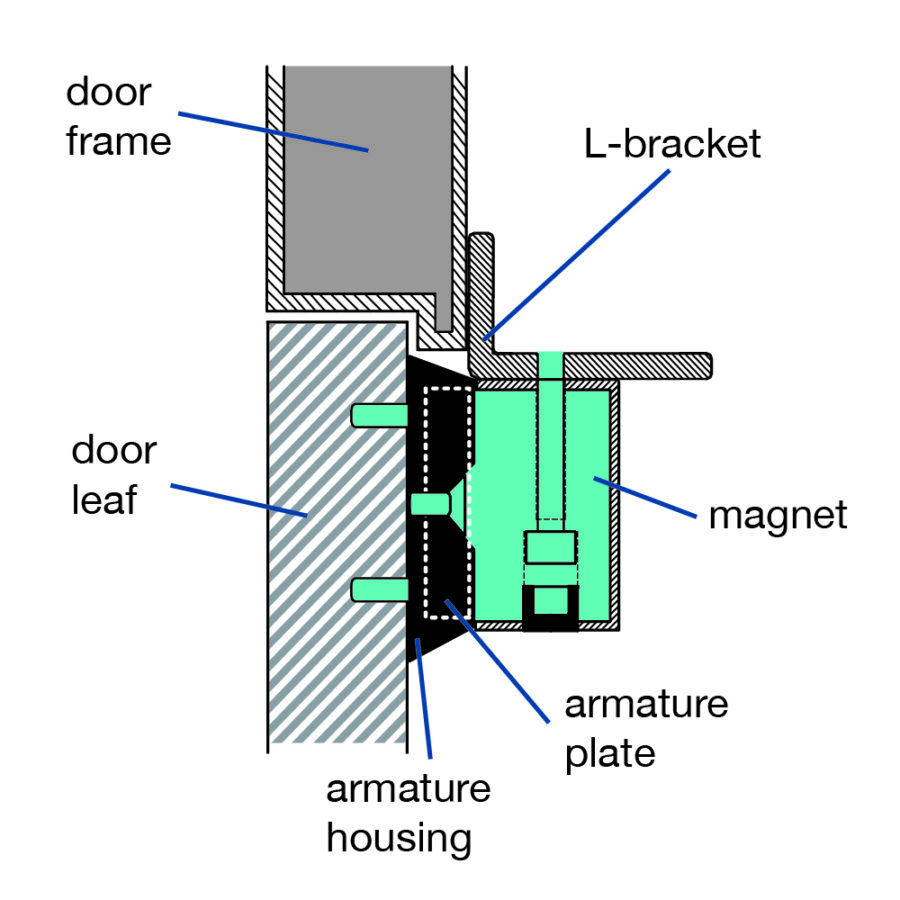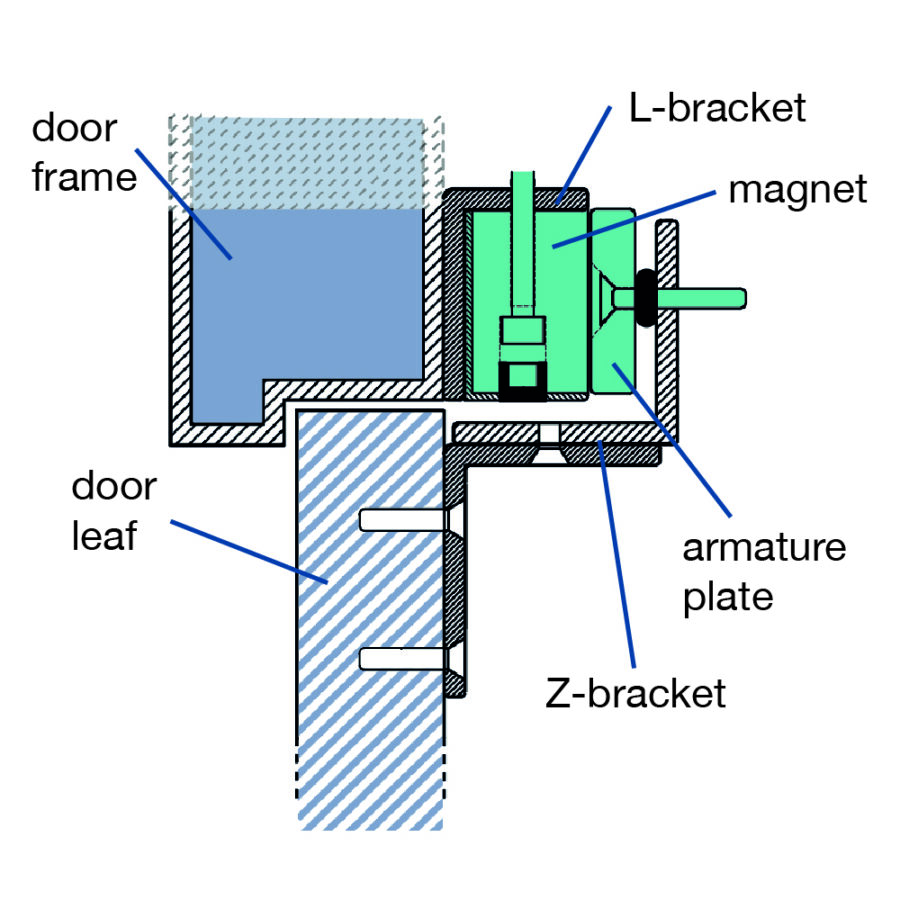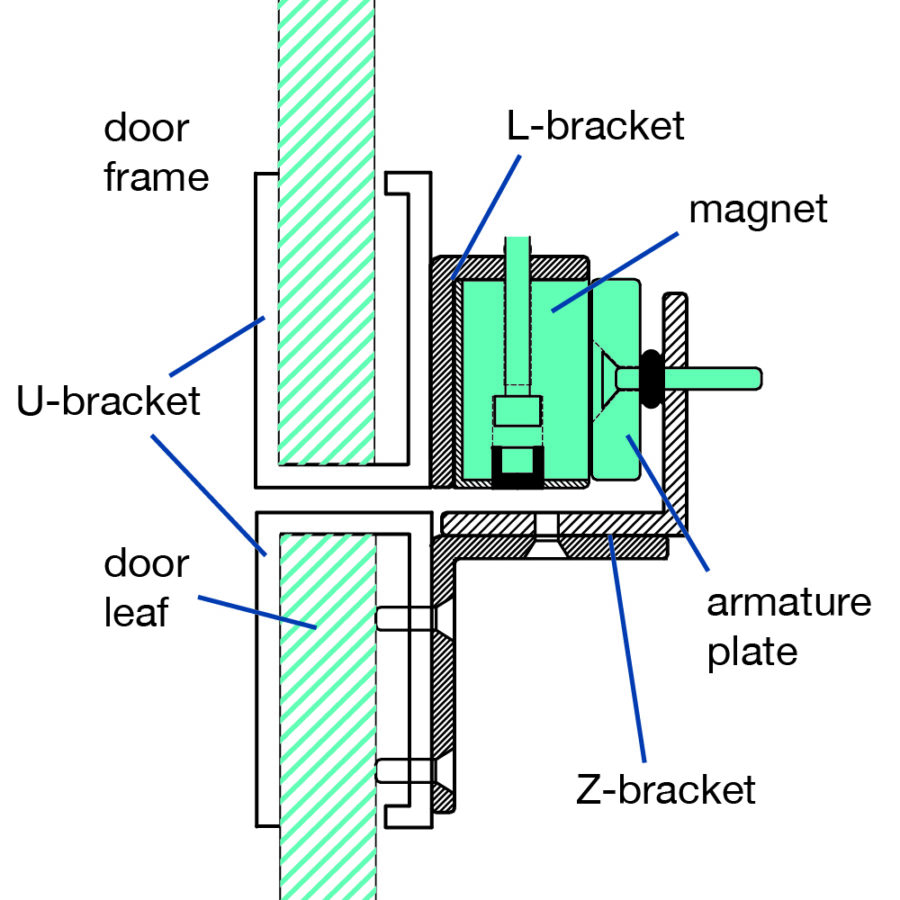Understanding maglocks is one thing. Knowing how to fit them is another. It’s never just as simple as picking up a maglock and screwing it to a door frame. You need to take into account the type of door, the direction it opens, and the material it’s made from. And then you need to identify and find the right brackets to allow you to safely mount the magnet.
Surface maglocks
Surface maglocks are mounted (clue’s in the name) on the surface of doors and door frames. The magnet is mounted on the door frame, and the corresponding armature plate is mounted on the door leaf. Depending on the door opening direction, different kinds of brackets will be needed.
How to mount surface maglocks on outward opening doors
To mount a surface maglock on a door that opens away from you, you will need:
- An electro-magnet
- An armature plate
- An L bracket
- An armature housing
- All the associated screws and bolts
The L bracket is fitted to the door frame. The orientation of the L depends on the reveal depth in the frame. In most cases, we recommend that you fix the long side of the L to the door frame and fit the magnet to the short side. This ensures your installation is as strong as possible, with the long side of the L fixed to the door frame. Whichever way you do it, the other side of the L bracket sticks out perpendicular to the door frame. The magnet is bolted to the underside of the protruding side of the L.
Meanwhile, the armature plate is fitted into the armature housing and mounted onto the door leaf. The armature plate and the magnet should be properly aligned.

How to mount surface maglocks on inward opening doors
To mount a surface maglock on a door that opens towards you, you will need:
- An electro-magnet
- An armature plate
- A Z&L bracket
- All the associated screws and bolts
The L bracket is fitted to the door frame, with the long side of the L against the frame and the short side sticking out perpendicular to the frame at the top (upside-down L). The electro-magnet is bolted to the underside of the short side of the L (inside the L).
One part of the Z bracket is fitted to the door leaf, with one side flat against the door and the other sticking out at a 90-degree angle at the top, to create a Z shape. Meanwhile, the armature plate is fitted to the other half of the Z bracket. The two rough sides of the Z bracket are matched and fixed together, with the exact positioning of the two dictated by the spacing needed for the armature plate.

How to mount surface maglocks on glass doors
To mount a surface maglock on an inward-opening door that is made of glass, you will need:
- An electro-magnet
- An armature plate
- A Z&L bracket
- Two U-brackets
- All the associated screws and bolts
On a glass door and glass frame, you can’t screw directly into the glass. An extra bracket is needed to allow you to mount the maglock. The additional bracket is called a U bracket, and it fits around the top of the door leaf and the bottom of the door frame (when the door frame or header is made of glass). These give you a metal base to then fit the usual brackets to.
The L bracket is fitted to the U bracket on the door frame, with the long side of the L against the U bracket and the short side sticking out perpendicular to the frame at the top. The electro-magnet is bolted to the underside of the short side of the L.
One part of the Z bracket is fitted to the U bracket on the door leaf, with one side flat against the U bracket and the other sticking out at a 90-degree angle at the top. Meanwhile, the armature plate is fitted to the other half of the Z bracket. The two rough sides of the Z bracket are matched and fixed together, with the exact positioning of the two dictated by the spacing needed for the armature plate.

For the configuration for glass doors on an outward-opening door, consult our brackets help sheet.
Other types of maglocks
This article covers surface mount maglocks only. If the maglock is mortice mounted so its surface is flush with the frame, then a different setup is needed. Keep your eyes peeled – more articles coming soon!
For more detailed information on our brackets and which models fit with which magnets, consult our handy brackets help sheet:
